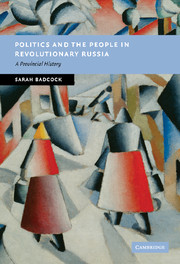Book contents
- Frontmatter
- Contents
- List of figures and table
- Notes on the text
- Acknowledgements
- Maps
- 1 Introduction
- 2 The February revolution: whose story to believe?
- 3 The Socialist Revolutionary Party and the place of party politics
- 4 Choosing local leaders
- 5 Talking to the people and shaping revolution
- 6 Soldiers and their wives
- 7 ‘Water is yours, light is yours, the land is yours, the wood is yours’
- 8 Feeding Russia
- Conclusions
- Bibliography
- Index
- NEW STUDIES IN EUROPEAN HISTORY
7 - ‘Water is yours, light is yours, the land is yours, the wood is yours’
Published online by Cambridge University Press: 10 August 2009
- Frontmatter
- Contents
- List of figures and table
- Notes on the text
- Acknowledgements
- Maps
- 1 Introduction
- 2 The February revolution: whose story to believe?
- 3 The Socialist Revolutionary Party and the place of party politics
- 4 Choosing local leaders
- 5 Talking to the people and shaping revolution
- 6 Soldiers and their wives
- 7 ‘Water is yours, light is yours, the land is yours, the wood is yours’
- 8 Feeding Russia
- Conclusions
- Bibliography
- Index
- NEW STUDIES IN EUROPEAN HISTORY
Summary
The power and authority of the Provisional Government crumbled palpably on the land question, as state policies were sidelined and local initiatives came to dominate discourse and action on land use. Preceding chapters have explored the role of political parties and leaders, and the ways in which the political elite tried to communicate with the population. Peasant responses to the land question allow us to explore grass-roots perspectives of the revolution, perceptions of duty and responsibilities towards government and state, and broader conceptions of justice. This chapter explores the practical political interactions both among local power structures, and between peasants and government, and reveals the irregularity of power and authority structures at all levels, as central government was unable to impose their orders, or even to intervene significantly. Connections between central and regional power frayed as regional administrations made autonomous decisions to resolve land relations. The inability of central authorities to control these independent initiatives accentuated the devolution of power and authority in Nizhegorod and Kazan, away from the centre and the provincial administration, and towards lower-level organisations.
This analysis of land policies formulated at regional level reveals that the divisions that emerged were not only between central government and ordinary people, but also between central government and local government. Local leaders played a key role in forming and directing land relations.
- Type
- Chapter
- Information
- Politics and the People in Revolutionary RussiaA Provincial History, pp. 181 - 210Publisher: Cambridge University PressPrint publication year: 2007

